ALFONSO XIII - BABY HEAD stamps of the PHILIPPINES
Catalogue
1mil issues
1890 1mil dark violet
Cliché Type I, Gum Type A.
Sheets of 100 (10 x10) inscribed IMPRESOS 2,000,000 from 20,000 sheets issued 12 June 1890
The colour of this issue was is generally described as “deep violet” or “dark violet”.
Bartels et al (1904) and Palmer (1912) also describe a seperate “black violet” shade. Galvez (1942) also describes a “black violet” shade.
The 1m impresos issue was not initially intended for postal use, although postally used examples can be found. However, a telegraphic order from the Minister of Colonies, dated of 13 June 1892 permitted the unused remainders of this issue (and also the 1890 2m and 1/8 c values) to be re-issued and made available for postage, along with the new 1892 issues of that date. It is recorded that 1,601,455 stamps of the 1m dark violet were re-issued. These are not listed separately as they can only be distinguished by dated postmarks.
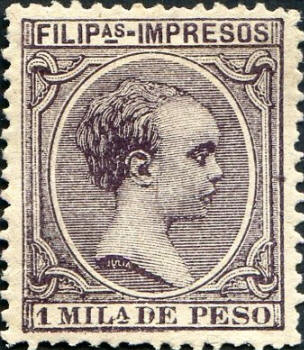
#MP101 1mil dark violet
Galvez (1942) records that all the 1m issue was printed on thin semi-transparent paper. Although various paper thicknesses are known the occurence of thin semi-transparent paper has yet to be confirmed (although may exist).

Sheet header for 1mil indicating usage as “IMPRESOS”

Only known example of single 1mil die proof, in violet on card

1mil dark violet plate proof - imperf

Only known example of 1mil perforated proof. The stamps can only be identified as part of a plate proof by the red serial number in the upper left hand corner
Edifil: #76 deep violet ‘violeta oscuro’ (12 Jun 1890)
Scott: #P9 dark violet (1890)
SG: #P171 deep purple (1 Jan 1890)
1892 1mil pale green
1893 1mil green
Cliché Type I, Gum Type A.
Sheets of 100 (10 x10) inscribed IMPRESOS 10,000 from 100 sheets pale green issued 1 January 1892
Sheets of 100 (10 x10) inscribed IMPRESOS 35,000 from 350 sheets dark green issued 13 June 1893
There were two issues of this printing, the first issued in January 1892 and the second approximately 18 months later on 13 June 1893. Mencarini (1896) describes the colour of the first printing as “pale green” and the second printing as “dark green”. Bartels et al (1904) similarly reports a colour differentiation: the first printing as “pale dull green” and the second as “bright emerald green” or “pale emerald green”.
The Spanish catalogues of that period do not record or differentiate the two printings. Of the popular modern catalogues only Stanley Gibbons differentiates between the two issues.
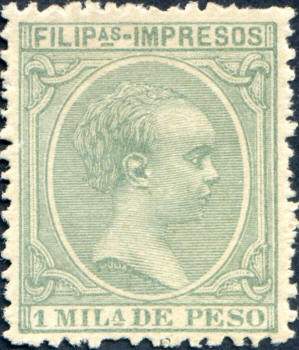
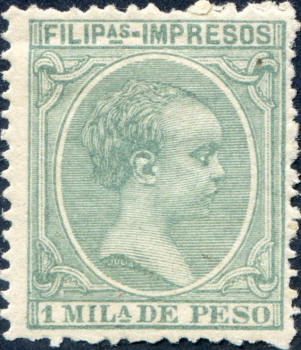
#MP102 1mil pale green and #MP103 1mil dark green
Peterson (PPJ 1999-3) also describes the two printings, although this largely repeats the information recorded by Mencarini and Bartels et al. However, Peterson suggests that the second printing was printed in late 1892 but not issued until 1893.
Peterson also provides a description of the gum type and reports this to be gum type A for both printings. However, it appears that a variety of gum types exist for this issue:
- gum type A – although the gum appears to have more of a sheen than normally encountered for this gum type
- gum type C – i.e. with a distinct cracked appearance to the gum
- gum with a high gloss
Edifil: #88 light green ‘verde claro’ (1 Jan 1892)
Scott: #P10 green (1892)
SG: #P188 pale green (1 Jan 1892)
Peterson, D. 1999. First and Second Printings of the 1890-1896 Postal Issues. Philippine Philatelic Journal, vol 21 no. 3, pp 9-15.
1894 1mil olive grey
Cliché Type I, Gum Type B.
Sheets of 100 (5 x10 - 5 x10 with gutter) inscribed IMPRESOS 600,000 from 6,000 sheets issued 1 January 1894
In general, the colour of this issue is described as “olive grey”.
Mencarini (1896) described the colour simply as “grey”. Bartels et al (1904) provide a description of shades varying between “olive-grey” and “grey-olive” with also “deep olive-grey” and “deep grey-olive”.
Cotter (1897) describes the colour as “violet” but this appears to be a typographical error.
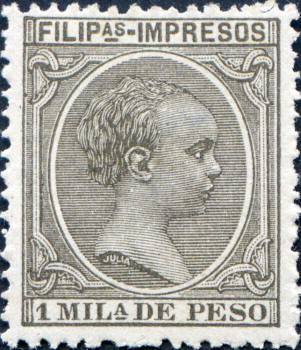
#MP104 1mil olive grey
Stanley Gibbons record the issue to be on thick paper. Similarly, Galvez (1942) notes that the stamps are on opaque paper.
However, examples of this issue on thin semi-transparent issues are also known to exist.
Gum Type B is the normal gum type for this issue. However, varieties with a high gloss gum are also known to exist.
The 1m olive grey issue comprises a different sheet format from the earlier issues as the sheet is divided in to two panes (5x10 – 5x10) separated with a gutter.
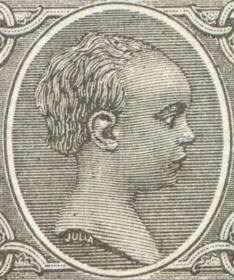
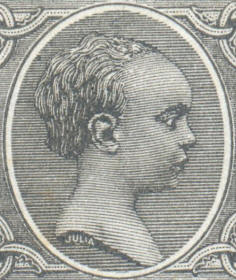
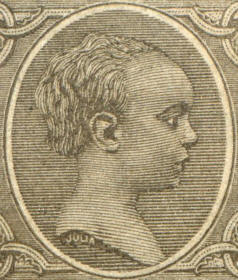
Examples of 1mil olive grey shade varieties,
the last example shows the significant effects on shade caused by toning, common in this issue
Edifil: #105 olive grey ‘gris oliva’ (1894)
Scott: #P11 olive gray (1894)
SG: #P197 olive-grey, thick paper (1 Jan 1894)
Gooding, N. 2017. Agencia Editorial Manuel Arias Y Rodriguez. Philippine Philatelic Journal, vol. 38 no. 1, pp 41-46.
1896 1mil ultramarine
Cliché Type III, Gum Type C and Gum Type D
Sheets of 200 (6 x10 - 8 x10 - 6 x 10 with two gutters) inscribed IMPRESOS 1,500,000 from 7,500 sheets issued 1 January 1896
The colour of this issue is generally described as “blue” or “ultramarine” with no significant shade variations mentioned.
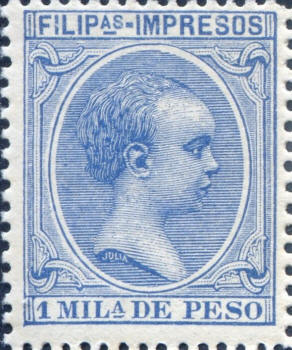
#MP105 1mil ultramarine
The setting of the sheets comprises three panes (6x10–8x10–6x10) each separated by a gutter. This was one of the larger sheets of 200 stamps that was adopted for a few issues in 1896. Palmer (PPJ 2015-1) indicates that the larger sheet represents a new base plate composed of clichés derived from the new die (die type III).
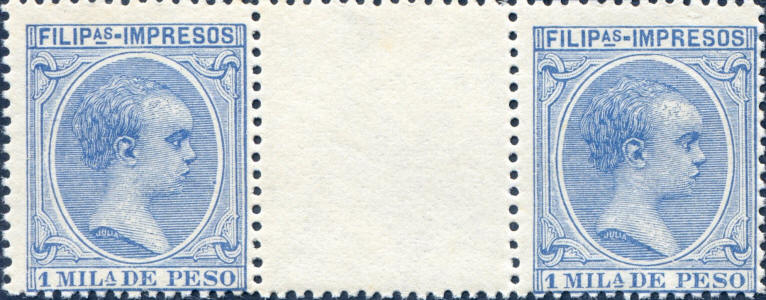
Gutter Pair
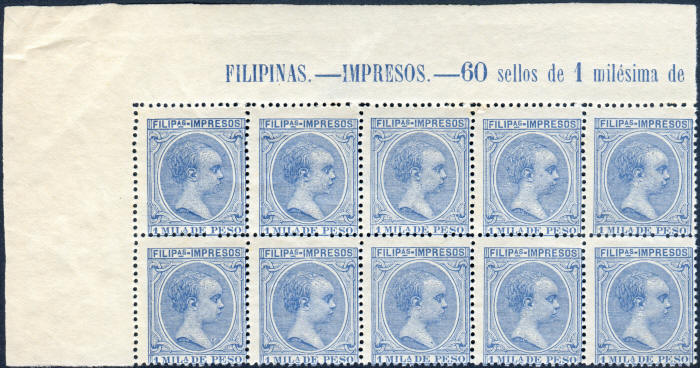
Sheet inscription indicating IMPRESOS use and left hand pane comprising 60 stamps

Sheet inscription indicating IMPRESOS use and central pane comprising 60 stamps
Edifil: #117 ultramarine ‘ultramar’ (1896)
Scott: #P12 ultramarine (1896)
SG: #P205 blue
Palmer, M. 2015. Cliché types in the Babyhead Issues. Philippine Philatelic Journal, vol 37 no. 1, pp 32-34.
Postal Usage

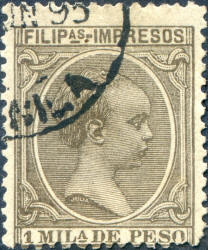
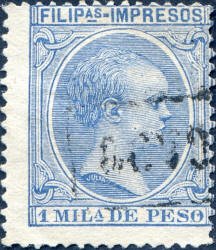
Circular date stamp [22 Feb] on 1m pale green
Circular Manila date stamp [Jun 1895] on 1m olive grey
Registration "Certificado" cancel (Peterson Type 6) on 1m ultramarine
Catalogue
Postal Issues
Newspaper Issues